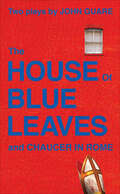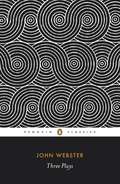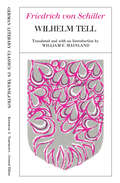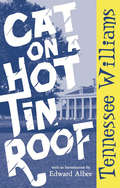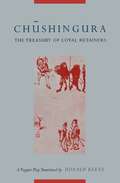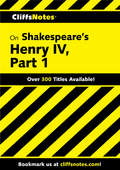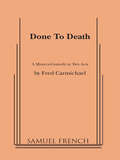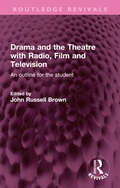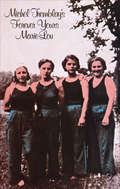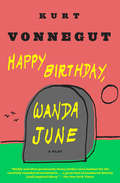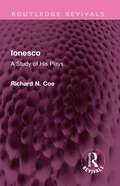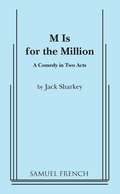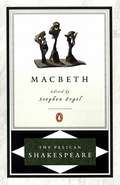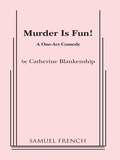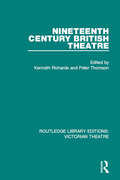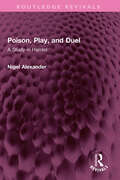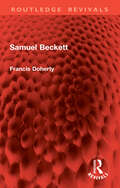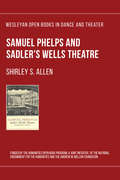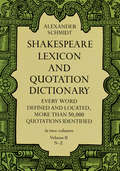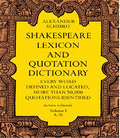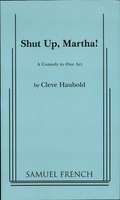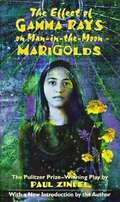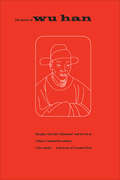- Table View
- List View
The House of Blue Leaves and Chaucer in Rome: Two Plays
by John GuareFrom an American playwright who “is in a class by himself,” two acclaimed plays linked by a character who comes of age in the sixties. (The New York Times)In John Guare’s classic play The House of Blue Leaves, winner of the New York Drama Critics Circle Award for best play, the Pope is visiting New York, and eighteen-year-old Ronnie goes AWOL from the army to come home to New York and blow up the Pope as he passes his house. In his new play, Chaucer in Rome, it is the year 2000, and Ron and his wife come to Rome to search for their son. With his inimitable wit and understanding, Guare has written two scathingly funny satires on the warping hunger for fame, and the betrayal involved in creating art.Praise for The House of Blue Leaves:“Splendid . . . a joyful affirmation of life and of John Guare’s artistry.” —The New York Times“A woozy, fragile, hilarious heartbreaker . . . the writing is lush with sad, ironic wisdom about fame, love, and deluded values.” —USA TodayPraise for Chaucer in Rome:“Guare makes us become voyeurs even as we scorn voyeurism—thus offering a titillating, troubling commentary on life.” —USA Today“Guare’s most disciplined, merciless yet lovable work since Six Degrees of Separation and maybe his best yet.” —New York Newsday
Three Plays
by John WebsterThe plays of Jacobean dramatist John Webster are masterpieces of early seventeenth-century English theatre. ‘The White Devil’ depicts a dark, sinister world of duplicity, intrigue and murderous infidelity, while ‘The Duchess of Malfi’ tells the macabre story of a woman who marries beneath herself and sets in motion a terrible cycle of violence. Unlike these revenge tragedies, ‘The Devil’s Law-Case’ asserts social order in a plot filled with twists of fate. Written at a time when the court of King James was rife with instability and corruption, Webster’s disturbing plays reflect this abuse of power and are known for their horrific vision of humanity – yet they are also some of the most rich, sophisticated dramas ever composed.
Wilhelm Tell
by Johann Christoph Friedrich von Schiller William F. MainlandWhen Schiller completed his play, Wilhelm Tell, as a "New Year's Gift for 1805" he foretold that it would cause a stir. He was right. In the midst of Great Power politics a play which drew substance from one of the fourteenth-century liberation movements proved both attractive and inflammatory. Since then the work as become immensely popular. This new English translation by William F. Mainland brings out the essential tragi-comic nature of Wilhelm Tell but also emphasizes its impressive formal unity. Schiller based his play on chronicles of the Swiss liberation movement, in which Wilhelm Tell played a major role. Since Tell's existence has never been proven, Schiller, a historian by profession, felt he had to devise a figure who would bring the uncertainties and contradictions of the various Swiss chronicles into focus. Respected for his courage and skill with a bow, for his peaceable nature and his integrity, Schiller's archer--while always ready to aid his fellows--habitually seeks solitude. In the midst of political turmoil Wilhelm Tell is the nonpolitical man of action. Keenly interested in the problematic interplay of history and legend, Schiller turned it to be dramatic advantage. He constructed his play to illustrate the greatest possible development of the character traits suggested for Tell by the chronicles. The result of Schiller's supreme achievement in historical drama.
Wilhelm Tell (German Literacy Classics in Translation)
by Friedrich von SchillerWhen Schiller completed Wilhelm Tell as a "New Year's Gift for 1805" he foretold that it would cause a stir. He was right. In the midst of Great Power politics a play which drew substance from one of the fourteenth-century liberation movements proved both attractive and inflammatory. Since then the work as become immensely popular. This new English translation by William F. Mainland brings out the essential tragi-comic nature of Wilhelm Tell but also emphasizes its impressive formal unity. Schiller based his play on chronicles of the Swiss liberation movement, in which Wilhelm Tell played a major role. Since Tell's existence has never been proven, Schiller, a historian by profession, felt he had to devise a figure who would bring the uncertainties and contradictions of the various Swiss chronicles into focus. Respected for his courage and skill with a bow, for his peaceable nature and his integrity, Schiller's archer—while always ready to aid his fellows—habitually seeks solitude. In the midst of political turmoil Wilhelm Tell is the nonpolitical man of action. Keenly interested in the problematic interplay of history and legend, Schiller turned it to be dramatic advantage. He constructed his play to illustrate the greatest possible development of the character traits suggested for Tell by the chronicles. The result of Schiller's supreme achievement in historical drama.
Cat on a Hot Tin Roof
by Edward Albee Tennessee WilliamsThe definitive text of this American classic--reissued with an introduction by Edward Albee (Who's Afraid of Virginia Woolf? and A Delicate Balance) and Williams' essay "Person-to-Person." Cat on a Hot Tin Roof first heated up Broadway in 1955 with its gothic American story of brothers vying for their dying father's inheritance amid a whirlwind of sexuality, untethered in the person of Maggie the Cat. The play also daringly showcased the burden of sexuality repressed in the agony of her husband, Brick Pollitt. In spite of the public controversy Cat stirred up, it was awarded the Pulitzer Prize and the Drama Critics Circle Award for that year. Williams, as he so often did with his plays, rewrote Cat on a Hot Tin Roof for many years--the present version was originally produced at the American Shakespeare Festival in 1974 with all the changes that made Williams finally declare the text to be definitive, and was most recently produced on Broadway in the 2003-04 season. This definitive edition also includes Williams' essay "Person-to-Person," Williams' notes on the various endings, and a short chronology of the author's life. One of America's greatest living playwrights, as well as a friend and colleague of Williams, Edward Albee has written a concise introduction to the play from a playwright's perspective, examining the candor, sensuality, power, and impact of Cat on a Hot Tin Roof then and now.
Chushingura: A Puppet Play (Translations from Asian Classics)
by Donald KeeneChushingura (The Treasury of Loyal Retainers), also known as the story of the Forty-Six (or Forty-Seven) Ronin, is the most famous and perenially popular of all Japanese dramas. Written around 1748 as a puppet play, it is now better know in Kabuki performances. In the twentieth century, cinema and television versions have been equally successful. Donald Keene here presents a complete translation of the original text, with notes and an introduction that increase the reader's comprehension and enjoyment of the play. <p><p>The introduction also elucidates the idea of loyalty. This traditional virtue, as exemplified in Chushingura, has never completely lost its hold on audiences, in spite of twentieth-century changes in Japanese society and moral ideas. Moreover, as Professor Keene points out, the excitement, color and violence expressed in the play may be considered the counterpoint to the austere restraint and understatement which are more commonly thought to be "traditionally" Japanese.
CliffsNotes on Shakespeare's Henry IV, Part 1
by James K LowersThis popular play entertains and inspires in alternating comic scenes and serious ones and is the birthplace of one of the theater's greatest characters, Sir John Falstaff. Young Prince Hal rebels against his father the king until he must go to the king's aid to stamp out the rebellion of nobles.
Done to Death
by Fred CarmichaelMystery Comedy / 8 m., 8 f. / Int. Once famous mystery writers involve the audience as they apply their individual methods to solving various murders. They include a couple who write sophisticated murders, a young author of the James Bond school, a retired writer of the hard hitting method and an aging queen of the logical murder. "Ingeniously packed into the script is a parody of every mystery plot, hero, and villain created in the past fifty years. The story alternates between reality and imagination as five mystery writers wrestle with the problem of writing a television mystery series. All around them murders occur." Glens Falls Post Star. "Carmichael plays a skillful and fast paced game of guess again with the audience.... Clever and rewarding." Bennington Banner. FEE: $75 per performance.
Drama and the Theatre with Radio, Film and Television: An outline for the student (Routledge Revivals)
by John Russell BrownFirst published in 1971, Drama and the Theatre with Radio, Film and Television is concerned with the nature of theatre as a subject for study and the ways of studying it. All its contributors have practical experience of staging plays for professional or student companies, or for both. Necessarily, attention is chiefly focused on the main elements of plays in performance in theatres, now and in the past. The chosen topics place more specialized studies in a wider context, because such a book as this needs, above all, to give an impression of general scope. It is intended for those aiming for a theatre career and for young students interested in theatre.
Forever Yours, Marie-Lou
by Michel Tremblay Bill Glassco John Van BurekTwo grown sisters confront the memory of their parents' tragic death.This revised edition of Forever Yours, Marie-Lou, which played at the 1990 Stratford Festival, is John Van Burek and Bill Glassco's translation of Michel Tremblay's original French text.Cast of 3 women and 1 man.
Happy Birthday, Wanda June: A Play
by Kurt Vonnegut&“Richly and often pertinently funny [with] a sure instinct for the carefully considered irrelevance . . . a great deal of incidental hilarity [and] inspired idiocy.&”—The New York Times Happy Birthday Wanda June was Kurt Vonnegut&’s first play, which premiered in New York in 1970 and was then adapted into a film in 1971. It is a darkly humorous and searing examination of the excesses of capitalism, patriotism, toxic masculinity, and American culture in the post-Vietnam War era. Featuring behind-the-scenes photographs from the original stage production, this play captures Vonnegut&’s brilliantly distinct perspective unlike we have ever seen it before. &“A great artist.&”—The Cincinnati Enquirer
Henry VIII
by William ShakespeareConspiracies and intrigue are rife in the court of Henry VIII as a Duke is executed for treason, having been tricked by the Cardinal. And when the King falls in love with Anne Bullen and decides to divorce his wife, he causes an irrevocable rift with the Catholic Church. After the King's secret marriage to Anne courtiers fall in and out of favour and deaths abound, with far-reaching consequences.
Ionesco: A Study of His Plays (Routledge Revivals)
by Richard CoeFirst published in 1971, Ionesco is a study of the plays written by the absurdist playwright Eugene Ionesco. Eugene Ionesco’s play La Cantatrice Chauve, first presented in 1950, established him as one of the most provocative leaders of post-war ‘Theatre of the Absurd’. By 1970, his work had been performed by leading actors and companies all over the world. The author attempts to understand this enigmatic playwright and his plays, while trying to explore the reasons behind his quick popularity. This book will be of interest to students of literature, drama, philosophy, and history.
M is for the Million
by Jack SharkeyComedy / 7-13m, 4-5f / Lenore has been living high on the income from her daughter's million dollar trust, but if Meg marries before her 25th birthday she gets the trust and Lenore will be penniless. The wedding is scheduled aboard a Mediterranean bound steamship. Complications abound as Lenore tries to stall the marriage, Meg's secret identity and additional fiances surface, a commercial spy intrudes, and a love mad Athenian is ready to marry mother or daughter. Love potions, a ship that can't decide where it's headed and other zany twists make this madhouse of activity great fun.
Macbeth
by William Shakespeare Stephen Orgel A. R. Braunmuller"I feel that I have spent half my career with one or another Pelican Shakespeare in my back pocket. Convenience, however, is the least important aspect of the new Pelican Shakespeare series. Here is an elegant and clear text for either the study or the rehearsal room, notes where you need them and the distinguished scholarship of the general editors, Stephen Orgel and A. R. Braunmuller who understand that these are plays for performance as well as great texts for contemplation." (Patrick Stewart) The distinguished Pelican Shakespeare series, which has sold more than four million copies, is now completely revised and repackaged. Each volume features: * Authoritative, reliable texts * High quality introductions and notes * New, more readable trade trim size * An essay on the theatrical world of Shakespeare and essays on Shakespeare's life and the selection of texts
Murder Is Fun!
by Catherine BlankenshipComedy / Catherine Blankenship / 7m, 7f / Captain Brown of the Homicide Squad asks the audience to solve a murder for him in this mystery satire. A composer has died under mysterious circumstances. His son, daughter, fiancee, servant and a lawyer re-enact incidents leading to his demise. Unable to deduce the guilty person, characters in the audience quarrel until the doctor breaks the case with a surprising statement. Originally produced at the Yale Experimental Theatre.
Nineteenth Century British Theatre (Routledge Library Editions: Victorian Theatre)
by KENNETH RICHARDS AND PETER THOMSONOriginally published in 1971. Nineteenth-century theatre in England has been greatly neglected, although serious study would reveal that the roots of much modern drama are to be found in the experiments and extravagancies of the nineteenth-century stage. The essays collected here cover a range of topics within the world of Victorian theatre, from particular actors to particular theatres; from farce to Byron’s tragedies, plus a separate section about Shakespearean productions.
Poison, Play, and Duel: A Study in Hamlet (Routledge Revivals)
by Nigel AlexanderFirst published in 1971, Poison, Play and Duel explores the dominant symbols of the language and action of Hamlet. The Ghost first reveals that Claudius murdered his brother by poison, and this act of poisoning is then dramatically presented before the King. The ultimate consequence of the ‘poison in jest’ performed by the actors is the poisoned ‘play’ with rapiers between Laertes and Hamlet. This representation of violence, and the vengeful response to violence, creates the moral and the psychological problems of Hamlet. Critics naturally question, and disagree about, the way that Hamlet plays his role in this play because the role of Hamlet is a theatrical device designed to bring all human actions into debate and question. It is hardly surprising that audiences have seen mirrored in Hamlet their own most fundamental and inescapable problems. Nigel Alexander shows how Shakespeare, like Raphael, Titian and other Renaissance artists, developed and adapted the imagery inherited from the Christian and classical past. The battle within the soul, the choice of life, the hunt of passion, the triple face of prudence and the dance of the graces are given dramatic habitation in Hamlet’s soliloquies, in the inner-play and in the savage contrast of sexuality between Gertrude and Ophelia. This book will be of interest to students of literature, drama, psychology and philosophy.
Samuel Beckett (Routledge Revivals)
by Francis DohertyOriginally published in 1971, this book elucidates Beckett’s work in the light of his concern with literary form. This is seen as an increasingly compressed and dense medium for the purer and purer statement of his view of man’s existence, and Beckett’s Man is seen as the medium for the articulation of a view of the world which is both comically cruel and anti-theological, but not atheist. The book discusses his work as a novelist and playwright – his best-known play, Waiting for Godot, being seen in the context of his many other important plays, and more than twenty years of previous writing.
Samuel Phelps and Sadler's Wells Theatre
by Shirley S. AllenThis is the definitive biography of the actor Samuel Phelps (1804-1878) who brought the Shakespeare’s original plays back to the forefront of theatre after over 100 years of derived versions, and revolutionized theater design in the 20th Century. In an era when performances of Shakespeare’s works had been replaced with derived versions of themselves, Phelps became known for his exquisite productions of Shakespeare that were faithful to their original versions. Phelps revolutionized Shakespearean theatre when he took over management of Sadler’s Wells Theatre. As manager and director, he brought to each production—whether of Shakespeare or of Restoration or contemporary pieces—his own total concept, in which acting, setting, and staging were integrated under his supervision to produce fresh, striking effects. He preserved the best of the traditional past; he pioneered in directions the theatre would follow for decades afterward. This carefully researched and fluently written book covers the full range of Phelps’s half-century career, with special emphasis on his fruitful decades at Sadler’s Wells and on his work as performer and producer of Shakespearian drama. Scholar Shirley S. Allen presents the background against which Phelps worked: the theatrical monopoly, traditional techniques of acting, the repertory system, the advent of melodrama, and the social milieu. She also examines Phelps’s important contemporaries in the theatre—Macready, Charles Kean, Ben Webster, Mrs. Warner, and more—especially as their careers were intertwined with his. This book, first published in 1971, is widely considered the definitive work on Phelps and adds substantially to our understanding of the London stage and of Victorian England.
Shakespeare Lexicon and Quotation Dictionary (Third Edition)
by Alexander SchmidtIn more than 300 years of Shakespearean scholarship, only one book, the famous Shakespeare Lexicon and Quotation Dictionary, has investigated the meaning of every word that Shakespeare wrote. The lifetime work of Professor Alexander Schmidt of Königsberg, this book has long been the indispensable companion for every person seriously interested in Shakespeare, Renaissance poetry and prose of any sort, or English literature. It is really two important books in one. <p><p> Schmidt’s set contains every single word that Shakespeare used, not simply words that have changed their meaning since the seventeenth century, but every word in all the accepted plays and the poems. Covering both quartos and folios, it carefully distinguishes between shades of meaning for each word and provides exact definitions, plus governing phrases and locations, down to the numbered line of the Cambridge edition of Shakespeare. There is no other word dictionary comparable to this work. <p> Even more useful to the general reader, however, is the incredible wealth of exact quotations. Arranged under the words of the quotation itself (hence no need to consult confusing subject classifications) are more than 50,000 exact quotations. Each is precisely located, so that you can easily refer back to the plays or poems themselves, if you wish context.Other features helpful to the scholar are appendixes on basic grammatical observations, a glossary of provincialisms, a list of words and sentences taken from foreign languages, a list of words that form the latter part of word-combinations. This third edition features a supplement with new findings.
Shakespeare Lexicon and Quotation Dictionary: A Complete Dictionary Of All The English Words, Phrases, And Constructions In The Works Of The Poet (Third Edition)
by Alexander SchmidtIn more than 300 years of Shakespearean scholarship, only one book, the famous Shakespeare Lexicon and Quotation Dictionary, has investigated the meaning of every word that Shakespeare wrote. The lifetime work of Professor Alexander Schmidt of Königsberg, this book has long been the indispensable companion for every person seriously interested in Shakespeare, Renaissance poetry and prose of any sort, or English literature. It is really two important books in one. <p><p> Schmidt’s set contains every single word that Shakespeare used, not simply words that have changed their meaning since the seventeenth century, but every word in all the accepted plays and the poems. Covering both quartos and folios, it carefully distinguishes between shades of meaning for each word and provides exact definitions, plus governing phrases and locations, down to the numbered line of the Cambridge edition of Shakespeare. There is no other word dictionary comparable to this work. <p> Even more useful to the general reader, however, is the incredible wealth of exact quotations. Arranged under the words of the quotation itself (hence no need to consult confusing subject classifications) are more than 50,000 exact quotations. Each is precisely located, so that you can easily refer back to the plays or poems themselves, if you wish context.Other features helpful to the scholar are appendixes on basic grammatical observations, a glossary of provincialisms, a list of words and sentences taken from foreign languages, a list of words that form the latter part of word-combinations. This third edition features a supplement with new findings.
Shut Up, Martha!
by Cleve HauboldComedy / 3m, 2f / Interior / On a stormy night, a mysterious cloaked figure appears in Benjamin Franklin's print shop to insist Ben print a letter "to save the country." The fun and confusion build until the visitor produces a basket of chocolates and casts off her disguise to reveal herself as Martha Washington. Wild eyed Martha plies the wary Ben with promises and peanut brittle to persuade him to publish her note in which she sees a Tory behind every tree. Ben tries to calm Martha, but she becomes a whirlwind of confusion, when George Washington himself angrily arrives to drag Martha back to Mount Vernon. A mad historical romp which shows how history can repeat itself.
The Effect of Gamma Rays on Man-in-the-Moon Marigolds: A Drama in Two Acts
by Paul ZindelBeatrice was a mother...and the embittered ringmaster of the circus Hunsdorfer featuring three generations of crazy ladies living under the sloppiest big top on earth. Nanny was no problem. She sat and stared and stayed silent as a venerable vegetable should. Ruth was half-mad and easily bought with an occasional cigarette. But how is the world would Beatrice control Tillie--keeper of rabbits, dreamer of atoms, true believer in life, hope, and the effect of gamma rays on man-in-the-moon marigolds...<P><P> Pulitzer Prize Winner
The Heresy of Wu Han: His play 'Hai Jui's Dismissal' and its role in China's Cultural Revolution
by Clive AnsleyAt the centre of China's Cultural Revolution in its first stages stands the ambiguous figure of Wu Han. Occupying until the mid-sixties a favoured position among the intellectual elite of the People's Republic, he was the eighth-ranking figure in the Chinese Communist Party, and his Peking Opera Hai Jui's Dismissal was performed all over China. Gradually it became apparent that Wu Han was using Hai Jui to lampoon Chairman Mao Tse-tung and the core policies of the CPP. Other dissidents began to pen articles and plays on similar themes. For several years Mao chafed under these literary attacks, but in late 1965 he retaliated. A sudden, scathing attack on Wu Han and his play by an obscure newspaper editor marked the beginning of the Cultural Revolution, a cataclysm in which the Party leadership was decimated while Mao regained full supremacy. This volume presents the first translation of Wu Han's plays and helps to clarify the obscure origins of a national phenomenon that was at once intellectual, social, and political.
